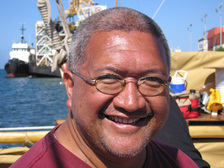
foot of Tantalus and fondly known as Beverly Hills, but the wealth was not in fancy cars and expensive houses, but in the rich forest playground of Nuʽuanu stream. From a very young age Chadd was in and around the ocean, while at the same time absorbing music and stories from his well-known song writing tutu wahine. But then like an unfamiliar breeze that seems to appear out of nowhere, playing old music on new fronds, Chadd’s whole
life changed.
I was about in the third grade, and I met this Hawaiian man who had just moved home from Chicago. He was
doing these children’s books for mainland elementary students about Hawaii. Me and about 4 other friends from my school, we basically got to play hooky, up at Nuʽuanu stream and he would take pictures of us or we would go to his studio and he would illustrate these pictures of us it was there at his studio that I started seeing pictures that might have been voyaging canoes, they were just pencil drawings but those drawings, I really got attached…At the end of the project, he was presenting checks to our parents, me and my friends, and I told my dad, ‘I don’t want the check. I want the picture that’s on the wall.’ He took it off the wall and he signed it and he gave it to me and that stayed on my wall as I was growing up.
Eventually the family moved to Nānākuli on the Waianae coast and it was all about the kai. To me I had the best of both worlds. At that time when I was growing up on Oʽahu, the only thing I knew about voyaging canoes, were the stories that my kupuna told me. At that time there were no books. Hōkūleʽa was not built yet. I knew about our paddling canoes because I paddled in canoes. But the stories of the voyaging canoes would only come to me because my grandparents told me the stories. It always fascinated me because I loved being in the ocean…Years later, the launching of Hōkūleʽa was coming around and in the newspaper on Oʽahu, I noticed this guy’s name…Herb Kane…It was that picture. Imagine standing on the beach in Nānākuli and thinking about our ancestors coming over the horizon.
here. What carried them to the shores of Hawaii was the knowledge and skills passed to them through centuries of voyaging. The search for a Polynesian navigator was unsuccessful, but the quest eventually lead to Satawal, a very
tiny island in Micronesia, and Papa Mau. …he brought us all together. He taught us to treat the canoe like our mother, because it’s the canoe that carries us on the ocean…that cares for us. So we care of it like we care for our own mothers. That respect is what we have for the canoe. The navigator becomes our father. He’s the one that teaches us everything that we need to know, directs us when we are on board the canoe so that we know what our function is.
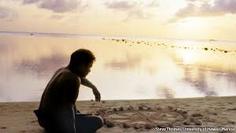
Hōkūleʽa through unfamiliar waters on her first voyage to Tahiti; the voyage from Hololua Bay, Maui, took 32 days. Over the horizon came this ancient, giant migrating bird returning home to add another segment to the stories.
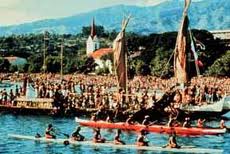
me hearing those stories. For many Tahitians, their stories were that their families left aboard voyaging canoes and they never saw them again. When this voyaging canoe came over the horizon, for those Tahitians, it was just the return of their family. That within their lifetime they could see a voyaging canoe again. So this had to be family returning. Many voyages followed that first one. Over the last 38 years Hōkūleʽa has sailed over 135,000 nautical miles. We’ve been able to do this because of those very simple lessons that we’ve learned. About remaining connected about knowing where we go.”
to go back to the forest, we need to malama, take care of those places.
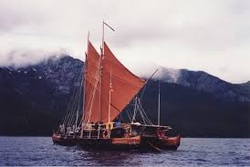
another life.
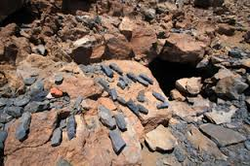
Nā Kālai Waʽa Comes to Life
The discovery in 1990 that the forest could not supply the logs for a voyaging canoe raised the awareness of another connection that needed to be mended, the construction of Mauloa (a smaller ocean going canoe) and the beginnings of Nā Kālai Waʽa . So it was back in the forest, that the story of Nā Kālai Waʽa really started to come full circle. Because of the effort of attempting to build a voyaging canoe and being made aware that it wasn’t possible at that time, the building of this smaller traditionally built coastal sailing canoe, Mauloa, became a reality…it would be something we could do so that we could remember what it is to build these canoes traditionally. By returning to Keanakekoi on Mauna Kea to get the stone to make our ko’i, to go back to the forest to find the tree, to practice all those things that are just left to us in stories. To reproduce a canoe as nā kālai waʽa , as canoe builders. Mauloa was launched from Honaunau, where it had been built, and …was really the solidifying piece that brought Nā Kālai Waʽa , which is our organization here on Moku ‘O Keawe, together, because it brought together all of our community from our kupuna to babies: from our elders who still hold the knowledge to our babies to pass that knowledge on.
The first decade and a half held many lessons, some of them bitterly hard. But beginning in 1991 there was an urge to start to pass on those hard earned lessons. This lead to the proposed 1992 voyage, No Nā Mamo (For the Children), intended to begin passing on this knowledge to the younger generations. The voyages to Raʽatea and Rarotonga were guided by newly trained navigators and a long distance educational program was set up that linked the classroom to the waʽa, inspiring a new generation of voyagers and inspired the formation of canoe
organizations on each of the islands.

Clay was our captain aboard Hōkūleʽa when we sailed back in 1992. When we returned from the voyage he had already started talking about building a voyaging canoe for the island, for Moku ‘O Keawe. For Clay it made sense to build another canoe to continue in the wake of Hōkūleʽa, because that’s where we come from. To continue to pass it on to the people here on the moku made sense to him. The second reason why he built the canoe was for his younger brother. Because Shorty was very close to Mau; Shorty was really Mau’s first student. This was Clay’s driving force behind the construction of a voyaging canoe for the Big Island and if anything, driving force is an understatement. I met Clay when my 7 year-old son visited Makaliʽi with his Boy Scout troop. Sitting Buddha-like on the navigator’s platform as a younger crew member spoke to the children, what was apparent was that he had a fierce energy beam focused on the group of youngsters standing on the deck; to him they were future
voyagers.
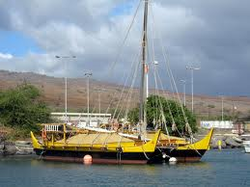
warehouse, on the Kona side, a few hundred yards before you get to the Chevron station, there’s the Parker Ranch green quonset hut. That’s where this canoe was built. When people heard we were building a canoe, what people thought we were building and what came out of the warehouse, were two different things. People thought we were building a 6 man paddling canoe, not this 54’ long, 20’ wide, double hulled voyaging canoe. So when it came out, it kind of caused a traffic jam in Waimea. Makaliʽi began a voyaging program that has shared the valuable lessons of voyaging to many near and far, serving both the island communities and the world community. Launching Makaliʽi back in 1995 was our way of continuing Hōkūleʽa, but doing it uniquely in the way of our Moku. That the canoe belongs to the community, that it’s part of the community. It’s always been in that sense for us with Makaliʽi that it’s in the service of the community, the service of home.
There was now a growing family of voyaging canoes in the Pacific. In 1995, Makaliʽi along with the other voyaging canoes throughout the South Pacific, all gathered in Tahiti together. It wasn’t just, as we call her mama, Hōkūleʽa. Mama was no longer alone. Now she had children. Traveling to the Marquesas and then traveling home to Hawaii together. If you look at the short time period from 1976 to 1995, it’s about 20 years that all these voyaging canoes started to take place within their own islands. Everyone started to remember.
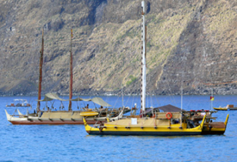
again to the ocean to close up the triangle they started back in 1987 and they traveled to Rapanui. We were able to sail to all these places and to touch all the islands that our people had traveled to generations ago. It was also at that time, as Hōkūleʽa sailed to Rapanui, that Clay Bertelmann in a conversation with Mau and in an understanding of how much Mau had given to us, asked what we could give back to Mau to say thank-you. Mau said, ‘Simple, a canoe.’ Clay said, ‘O.K.’ For all of us, we knew that once Clay committed to something, that was it. No matter if we didn’t have the money, we had the money or what, a canoe was going to somehow manifest itself.”
And manifest itself it did, the spirit of the canoe energizing the many hands from Moku ‘O Keawe and other moku who came together offering labor, food, tools, skills, materials and music or whatever it was they had to offer. All was accepted. And from this tremendous effort, Alingano Maisu was born. We had thought that Mau would want more of a Micronesian canoe in the beginning because he comes from Micronesia. But in Mau’s wisdom, he said, ‘No, I want a Hawaiian voyaging canoe.’ The reason being was that Mau wanted his people to remember the connection, the bridge as Mau puts it, the bridge that he had built, the bridge being the canoe. So that when the people in Micronesia see the double hulled voyaging canoe, they’ll remember the connection to Hawaii and they won’t forget that we’re connected. That the ocean connects us and not separates us. This is reflected in the name Alangano Maisu, which refers to a special wind. In Micronesia where the chiefs still rule, you cannot pick breadfruit unless the chief tells you, you can. But when a wind blows that knocks the fruit from the trees, then anyone can go pick it up, it’s free. The voyaging canoe is for everyone.
Clay passed away before Alingano Maisu could be completed, but in 2007 Alangano Maisu was sailed to Satawal to be presented to Mau, where he planned to bestow Pwo on Kalepa Baybayan, Nainoa Thompson, Shorty Bertelmann, Bruce Blankenfeld and Chadd. At first we were nervous about being given Pwo. We didn’t want to cause bad feelings, because we were outsiders to Micronesia. Also, this was the first time Pwo had been performed in public since Mau received his Pwo. Like with so many islands, when Christianity entered many traditions got put on the side, so he was the last one to be given Pwo.
By giving us Pwo, Mau was finding a way to build another bridge across the Pacific. Mau had that vision as a navigator to see far beyond the horizon 30 years ahead. When in his island home it was looked down upon to share knowledge
outside the family because the more knowledge your family held, the higher up in status you would be. But because Mau had started to see change in his island, Mau always told us, you cannot keep things like this, you have to be like this (open arms, palms out). Very simple but powerful. In that sense for Mau, that knowledge that he held, as a navigator, as a home builder, as a fisherman, as the doctor, as the farmer, as the one who made line, who made rope…it was also his responsibility to teach, to pass on his knowledge because he held Po. As Po, you feed your island and you teach, you share your knowledge.
The knowledge that arrived with the first Polynesians is what made it possible for the growth of a thriving
new branch of the Pacific family tree. Through the voyaging canoes, those stories and lessons were remembered and brought to life. From that tiny island, Mau touched the world because of what he was taught from the age of 3. In passing on Mau’s story, passing on Mau’s tradition, Mau always lives. Even though he passed away a few years ago, he’s still very much a part of our voyages. He’s still very much here with us. It’s really in that sense that we pass on to the next ones that follow after us.
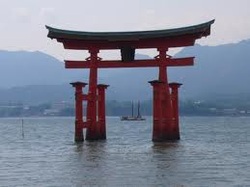
worldwide voyage are connections and stories. “The first year of the voyage will be in the Pacific re-connecting with families. On the voyage we will be connecting to the planet. Not to get answers so much but to learn. Along the way we will be looking at the health of our oceans and looking at all the changes that are happening to bring home the stories and see the possibilities, what can be done.”
The voyaging endeavor is really all about awakening and sharing old stories, old knowledge and moving
forward by connecting to the past, just as the navigator when departing uses an island landmark as an anchor to set a course forward. Voyaging is also about learning to read the world and locate ourselves within it. To venture onto the ocean is to let go of the delusion of control and develop the ability to read a world in constant motion while maintaining a still-point. Laying on his backside the navigator reads the ocean using the vibrations of wave patterns as they come through the hull and length of his body. Standing on the deck he is another still point as he observes the interwoven patterns indicative of nearby landmasses. It takes close observation and the ability to synthesize all the signs such as the appearance of migratory and pelagic birds, cloud types and patterns, and the patterns of the rising and setting stars.
But the real work of the voyagers will not be on the ocean but perpetuating the voyaging life on land.
“There are currently 8 voyaging canoes in the Hawaiian Islands and over 1000 crew members, which means there is a very small opportunity to get on a voyaging canoe. Not even half will get on board for the world voyage.” But the skills and knowledge that have been learned on the ocean are even more important on the land. Malama, to help; ‘imi ‘ike: to always seek understanding, knowledge, awareness; lokomaika’i: share what you have; na’au
pono: nurture a deep sense of justice; olakino maika’i: live healthily; kala: unlimited mind; makia: where the attention goes, there is your life; manawa: be in the present; aloha: joyful sharing of life energy.
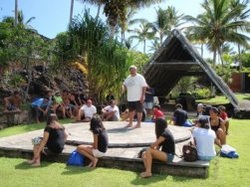
the same principles that perpetuated a sustainable island life for many
centuries and by reconnecting with the ʽāina and each other, we are offered a way forward. Our teacher told us a long time ago, that we have to see the island in here before we see it physically with our eyes. As long as you can always see it in here (inside your heart), that you’ll never be lost. So it’s really in that sense of knowing it in here, that really allows us to go anywhere, because we remember where we come from. It’s when we become paʽa to our place, paʽa kuahiwi keali’i kua paʽa….that allows us to continue to do these voyages…It’s important that our young ones, our babies know how special this place is, and find a way to connect to it; this is the gift of voyaging.
Our story isn’t very old, but it is, because it comes from our traditions…Maybe someone like me in 3rd grade will be inspired to step on the deck of a voyaging canoe. Or maybe be inspired to be in the forest. Our part as voyagers is to share the lessons of the canoes with our communities and bring back the stories.
 RSS Feed
RSS Feed
